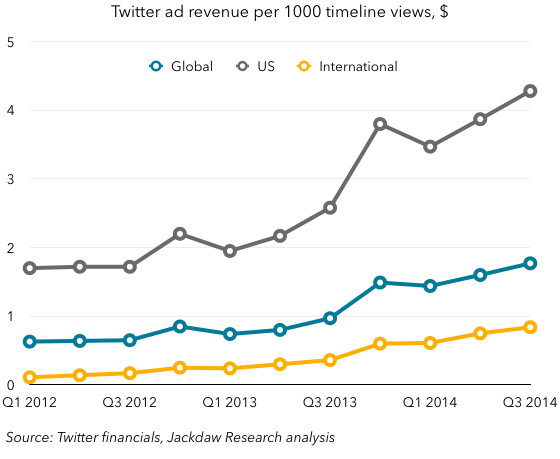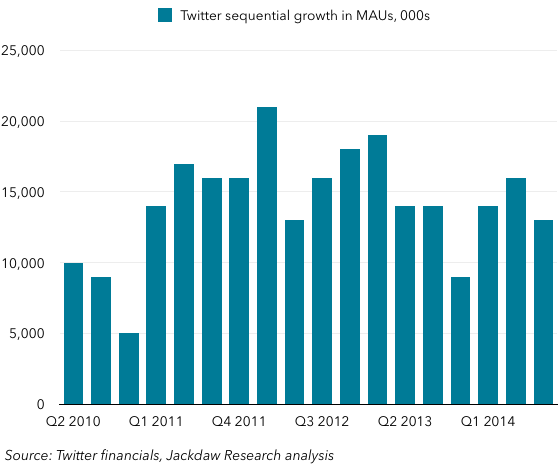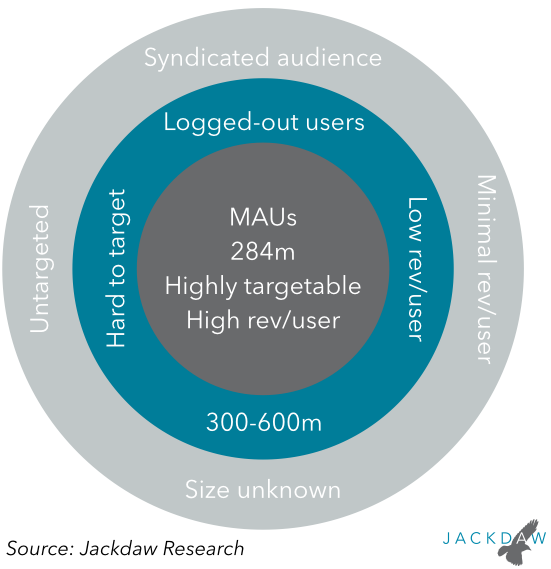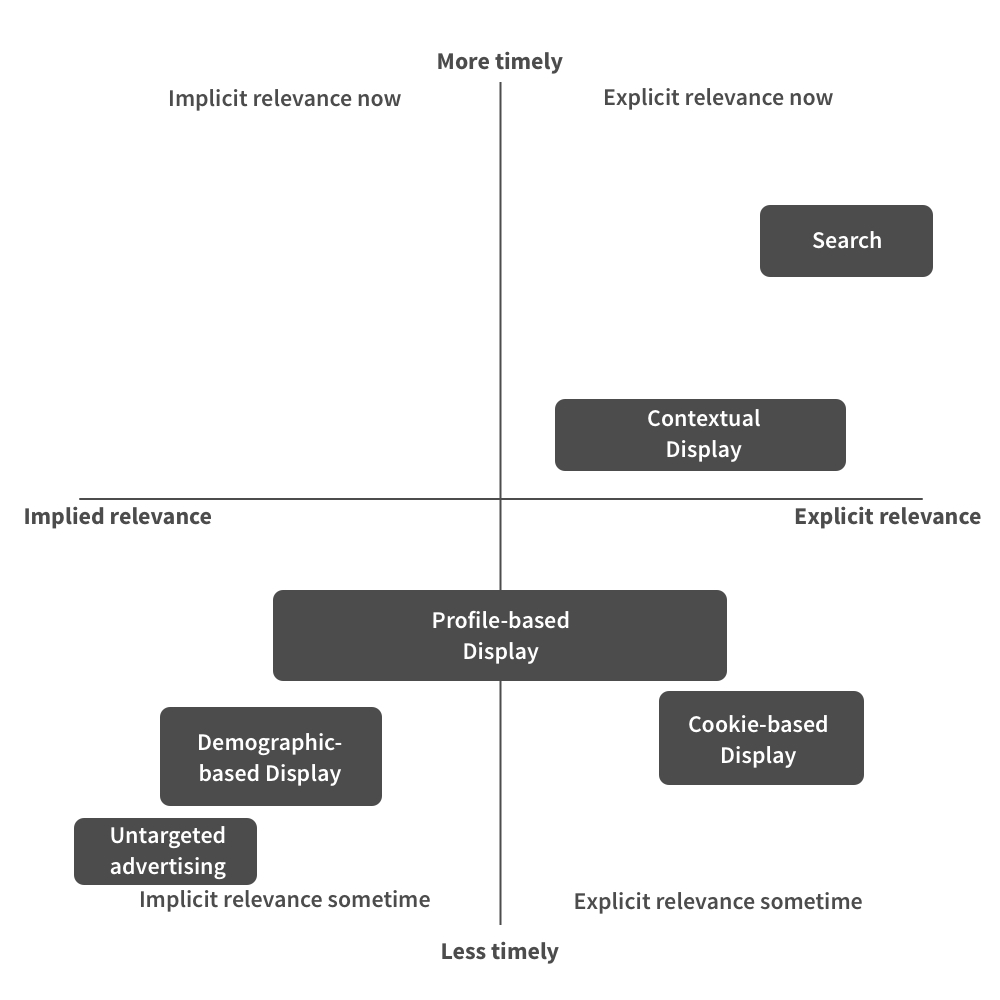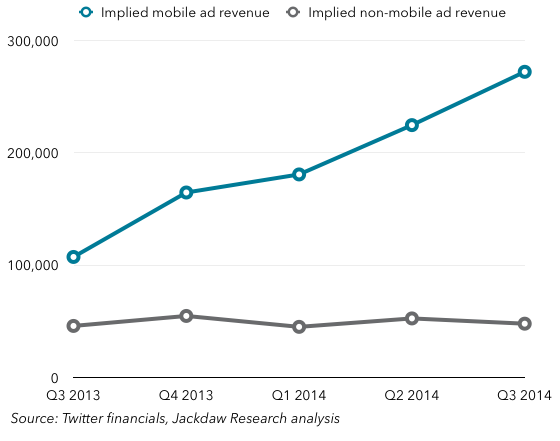Note to new readers: this is part of a series on major tech companies’ Q3 2014 earnings. I do similar analysis each quarter for certain companies. Previous pieces on Twitter may be found here.
Last quarter I talked a little about the challenge of Twitter’s user growth, and what I uncovered as its renewed emphasis on logged-out users (a theme Dick Costolo had first talked about three years ago and to which he has now returned). I and others have talked about Twitter’s different user groups and on yesterday’s earnings call Costolo explicitly spoke about three concentric circles (he actually said eccentric, but I’m fairly certain he meant concentric) representing Twitter’s users. That’s something I’ll return to below. There will be three major points to this analysis:
- Twitter has given us metrics to measure its growth and potential, but it keeps backing away from or hedging on these without providing better ones
- Twitter’s core user growth has slowed in recent quarters, and though it wants us to think about a broader group of users, this broader group is both ill-defined and much harder to monetize
- Twitter is very successfully managing the same transition to mobile advertising as Facebook, but it’s not yet clear how sustainable this business will be for either company.
Twitter’s metrics aren’t telling a good story
The three main metrics Twitter has established for tracking its progress are:
- User growth: as measured by growth in monthly active users (MAUs)
- Engagement: as measured by timeline views per MAU
- Monetization: as measured by ad revenue per thousand timeline views.
These three may be seen as levers, or multipliers, for growth. To the extent that all three are improving, they should drive faster and faster growth for the company, as each change in the first is magnified or multiplied by growth in the second, which in turn is magnified or multiplied by the third. The challenge is that of these three metrics, only one is heading in the right direction, and that’s ad revenue per thousand timeline views:
As you can see, international monetization continues to lag significantly behind US monetization, which is a function both of Twitter’s underdeveloped overseas sales channels for ads and the lower ad spend in every other market around the world. But both sets of numbers are moving in the right direction, and in the case of US revenues very rapidly so. I’ll come back to the drivers for this growth later, but this is the single best sign about Twitter’s business: it’s able to monetize what usage there is better and better, and this in turn has driven strong overall growth in ad revenues (in thousands of dollars):
The challenge is that this growth is strongly tied to direct sales, which is an expensive proposition in its own right. Even as some of Twitter’s other cost lines have shrunk as a percentage of revenue, sales and marketing costs are rising over time:
Note that this line excludes stock-based compensation, which adds significantly to the overall cost of these efforts. With SBC included, sales and marketing costs are equivalent to 45% of revenue. Now, Twitter does have self-service channels for selling ads, but they’re not filling up to the extent that they are making a meaningful dent in the overall ad load – the vast majority of Twitter’s ad sales are still made directly. That has to change to make this growth more sustainable and less expensive, which is critical to Twitter’s long term growth and profitability. It is rolling out those self-service tools to more markets, but it isn’t making much of a difference yet.
User growth – the foundation of overall growth – has slowed significantly. The chart below shows sequential growth in MAUs over the past few years, and it added just 13 million this quarter:
As you can see, with the exception of Q4 last year, which was a monumentally poor quarter for user growth, Twitter hasn’t added fewer than 13 million in a quarter since the fourth quarter of 2010. Growth has slowed significantly in recent quarters from its peaks in 2011 and 2012, and this is a major worry. To put things in context, Facebook has well over a billion MAUs and growing, while Amazon – obviously a very different business – has roughly the same number of active customer accounts as Twitter has MAUs. My point here is this: if you want to be a big business, you can either be a billion-plus-user company like Facebook and monetize each user modestly, or a quarter-billion-user company like Amazon and monetize them much more aggressively. But you can’t be a quarter-billion-user company and monetize them modestly and still be a big company. Hence the focus on other user metrics which I’ll come back to later.
As far as engagement goes, the story’s unfortunately bad there too, especially in Twitter’s most important market, the US:
A few quarters ago, Twitter explained that it would see some softness in this number in the short term because of changes to its apps, which would cause the number of timeline views to go down even as engagement improved. However, we should be long past those effects and yet timeline views per MAU are still falling in the US quarter-on-quarter and year-on-year. International timeline views per MAU have flattened too in the past quarter, another worrying sign.
New metrics needed, but Twitter won’t provide them
I’ve focused so far on the metrics Twitter has in the past suggested we should use to measure their progress. However, on both last quarter’s earnings call and yesterday’s call, the company recited a variety of other data points which it hopes will tell its story better. But it isn’t yet providing this data consistently, and it isn’t convincingly explaining why the existing metrics look so bad.
One good example of this is Costolo’s renewed emphasis on logged-out users. I decided to make his concentric circles concept into a concrete diagram, and add some detail which I think is critical to understanding the limitations of this argument:
The point Costolo makes is that the true Twitter audience is much broader than the MAU number it’s focused on for so long, because of the two outside circles. The key challenge, though, is that although this audience is much bigger, it’s much harder to monetize, because Twitter knows far less about these users and can track them far less effectively, which makes them much less attractive to advertisers. Given Twitter’s challenges in filling its ad inventory even for its MAUs, how is it ever going to increase load for these other groups? I’ve talked before about the most effective forms of online advertising, and the challenge for Twitter is that much of these larger user groups falls into the less attractive categories below:
Twitter’s mobile growth is impressive, but is it sustainable?
Twitter is beginning to follow a similar trajectory to Facebook in its impressive mobile growth. Of course, Twitter has always had a significant mobile component, but its transition in this direction is still impressive. Twitter doesn’t directly report mobile advertising and non-mobile advertising, but it provides enough information that we can derive them with some accuracy, as shown in the chart below (the numbers are in thousands of dollars):
As you can see, mobile advertising is ramping strongly, while non-mobile ad revenues are flat or declining. This is a very similar picture to Facebook’s, and the components of this growth are starting to be similar too. Twitter’s executives specifically called out the contribution of mobile app install ads as a driver on yesterday’s earnings. I’ve talked before about the questionable sustainability of app install ads as a growth driver, and I continue to worry about that as a driver for ad revenue for Twitter and other companies investing aggressively in this space. But more importantly Twitter’s syndicated and logged-out usage is likely to be heavily browser-driven, rather than app-driven, and there will be far less scope for advertising in those environments than in the app environment. The mobile ad revenue growth is fantastic, but Twitter’s wider user groups are far less likely to engage in the Twitter app, which means Twitter needs ad products that will work better on both mobile and desktop browsers.
